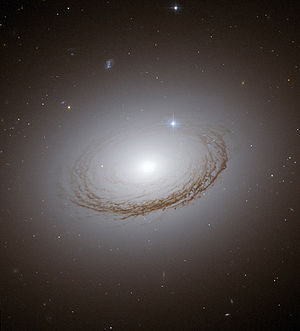NGC 7049
| Galaxy NGC 7049 |
|
|---|---|

|
|
|
Hubble Space Telescope - Image taken by NGC 7049 At the ring there is a star in the foreground. |
|
| AladinLite | |
| Constellation | Indus |
|
Position equinox : J2000.0 , epoch : J2000.0 |
|
| Right ascension | 21 h 19 m 00.3 s |
| declination | -48 ° 33 ′ 44 ″ |
| Appearance | |
| Morphological type | SA (s) 0 ^ 0 ^ |
| Brightness (visual) | 10.6 mag |
| Brightness (B-band) | 11.6 mag |
| Angular expansion | 4.5 ′ × 3 ′ |
| Position angle | 57 ° |
| Surface brightness | 13.3 mag / arcmin² |
| Physical data | |
| Affiliation | LGG 444 |
| Redshift | 0.007622 ± 0.000020 |
| Radial velocity | 2285 ± 6 km / s |
|
Stroke distance v rad / H 0 |
(101 ± 7) x 10 6 ly (30.9 ± 2.2) Mpc |
| history | |
| discovery | James Dunlop |
| Discovery date | 4th August 1826 |
| Catalog names | |
| NGC 7049 • PGC 66549 • ESO 236-1 • IRAS 21156-4846 • 2MASX J21190024-4833432 • SGC 211537-4846.5 • GC 4651 • h 3860 • Dun 406 • AM 2115-484 • LDCE 1456 NED004 | |
NGC 7049 is a lenticular galaxy of Hubble type S0 in the constellation Indus the southern sky , the 101 million light-years from an estimated Milky Way is removed. The system represents an intermediate state between a spiral galaxy and an elliptical galaxy .
It has an apparent visual magnitude of 10.6 mag and an angular extent of 4.4 '× 2.9'. However, due to its declination of −48 ° 33 ′ 43 ″, it is too far south to be observed from Central Europe. An image taken with the Hubble Space Telescope shows their appearance in visible light, which has an unusual ring of dust.
The object was discovered on August 4, 1826 by the Scottish astronomer James Dunlop , this discovery was later recorded in the New General Catalog .
Web links
- SIMBAD Astronomical Database
- LCO image
- astronews.com: Giant galaxy with dark clouds of dust April 8, 2009
- astronews.com: Picture of the day August 31, 2012
